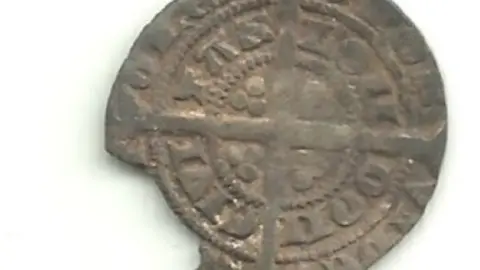Medieval coin found in Stoke-on-Trent garden raspberry patch
 Birmingham Museums Trust
Birmingham Museums TrustA university lecturer uncovered a coin believed to be more than 660 years old while digging in his garden.
Dr Jamie Pringle said he was weeding his raspberries at his home in Stoke-on-Trent when he noticed something metallic in the soil.
The object he uncovered was a silver groat from the time of Edward III which experts have dated to either 1352 or 1353.
Staffordshire's finds liaison officer said it was the only coin of its kind found within the city.
"It looked bit weird, I thought it looked quite old, then I saw the cross on it," said Dr Pringle, a senior lecturer in geosciences at Keele University.
He scanned the coin and sent it to the local finds liaison officer, who would be tasked with recording archaeological objects found by members of the public.
She confirmed the coin was issued during Edward III's reign and was minted in London.
Allow X content?

"I don't know what happened or why it was there," said Dr Pringle.
"It is quite exciting."
The coin could not be declared treasure under the Treasure Act 1996 as, although it would meet the requirement of being more than 300 years old, treasure status would require there to be at least two coins in a find.
Because of the lockdown due to the coronavirus outbreak, the discovery has been recorded remotely.
Victoria Allnatt, Staffordshire and West Midlands finds liaison officer, said although Edward III groats were not particularly rare, with 873 found across England and Wales, only 20 had been found in Staffordshire from that period.
"When we plot those on a map, this example found by Jamie is the only one discovered in the city itself," she said.
"The next nearest one was discovered in Barlaston and then Draycott in the Moors."

Follow BBC West Midlands on Facebook, on Twitter, and sign up for local news updates direct to your phone.
